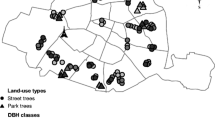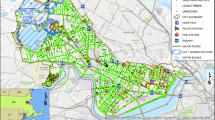Abstract
Key message
Street trees are vulnerable to extreme climate conditions such as precipitation, wind gust and high temperatures. But trees may also fail in the cities as a result of poor stewardship.
Urban trees are renowned for improving the livability in the cities through their ecosystem services. Long-lasting services, however, are only possible if local responsible authorities adequately manage the trees. Wood decay, inappropriate pruning, presence of xylophagous organisms, trunk constriction by the sidewalks, altogether increase the probability of trees to fall under adverse climate conditions. Tree fall is closely related to disservices like damages to the infrastructure, risks of injury and death. Given the previously reported poor conditions of the street trees in São Paulo/Brazil, one of the world’s largest cities, we assessed the main climate causes of tree fall. We evaluated a 3-year daily series of fallen trees in the city. The effects of precipitation, wind gust and temperature were evaluated using cross-wavelet analyses. Out of the 652,000 street trees of São Paulo, 7034 fell in the city during this period. Cross-wavelet analyses revealed that tree fall is seasonal and in phase with, and driven by, precipitation, wind gust and temperature during the wet season. While temperature directly influences tree fall, both precipitation and wind gust may show lagged effects. Such associations with climate were not observed during the dry season despite the records of fallen trees. Falling trees were observed in two-thirds of the days during the dry season. Although it could be partially caused by lagged effects of precipitation and wind gust, these records during the dry season confirm the poor stewardship and conditions of the street trees in the city. This study highlights how vulnerable street trees are to extreme climate conditions and that yet poorly managed trees fall on the streets daily without any apparent climate causes.




Similar content being viewed by others
References
Abreu-Harbich LV, Labaki LC, Matzarakis A (2015) Effect of tree planting design and tree species on human thermal confort in the tropics. Landsc Urban Plan 138:99–109
Asgarzadeh M, Lusk AC, Koga T, Hirate K (2012) Measuring oppressiveness of streetscapes. Landsc Urban Plan 107(1):1–11
Berland A, Shiflett AS, Shuster WD, Garmestani AS, Goddard HC, Dl H, Hopton ME (2017) The role of trees in urban stormwater management. Landscape Urban Planning 162:167–177
Brazolin S (2009) Biodeterioration, wood anatomy and falling risk analysis of tipuana, Tipuana tipu (Benth.). O. Kuntze trees, in the sidewalks of São Paulo city, SP. PhD Thesis, ESALQ –University of São Paulo, Piracicaba, São Paulo, Brazil, p 265
Conway TM, Yip V (2016) Assessing residents' reactions to urban forest disservices: a case study of major storm event. Landscape Urban Plan 153:1–10
Cumming AB, Twardus DB, Nowak DJ (2008) Urban forest health monitoring: large-scale assessments in the United States. Arboricult Urban for 34(6):341–346
Dahle G, Grabosky J, Kane B, Miesbauer J, Peterson W, Telewski FW, Koeser A, Watson GW (2014) Tree biomechanics: a white paper from the 2010 International Meeting and Research Summit at the Morton Arboretum (Lisle, Illinois, US). Arboric Urban for 6:309–318
Dale AG, Frank SD (2014) The effects of urban warming on herbivore abundance and street tree condition. PLoS ONE 9(7):e102996
Duryea M, Kampf E (2007) Wind and trees: lessons learned from Hurricanes. University of Florida FOR-118, Gainesville
Escobedo FJ, Kroeger T, Wagner JE (2011) Urban forests and pollution mitigation: analyzing ecosystem services and disservices. Environ Pollut 159:2078–2087
Ferreira LS, Duarte DHS (2019) Exploring the relationship between urban form, land surface, temperature and vegetation indices in a subtropical megacity. Urban Clim 27:105–123
Gardiner B, Berry P, Moulia B (2016) Review: wind impacts on plant growth, mechanisms and damage. Plant Sci 254:94–118
Ghani MA, Stokes A, Fourcaud T (2009) The effect of root architecture and root loss through trenching on the anchorage of tropical trees (Eugenia grandis Wight). Trees Struct Funct 23:197–209
Gonçalves R, Linhares C, Yojo T (2020) Drag coefficiente in urban trees. Trees Struct Funct. https://doi.org/10.1007/s00468-019-01951-1
Huang YS, Chen SS, Lin TP (2005) Continuous monitoring of water loading of trees and canopy rainfall interception using strain gauge method. J Hydrol 311:1–7
Jackson WA, Volk RJ (1970) Photorespiration. Annu Rev Plant Biol 21:385–432
Jim CY, Liu HHT (1997) Storm damage on urban trees in Guangzhou, China. Landsc Urban Plan 38:45–59
Kudryavtsev A, Krasny ME, Stedman RC (2012) The impact of environmental education on sense of place among urban youth. Ecosphere 3(4):1–15
Kuruneri-Chitepo C, Shackleton CM (2011) The distribution, abundance and composition of the Eastern Cape, South Africa. Urban for Urban Green 10:247–254
Langre E (2008) Effects of wind on plants. Ann Rev Fluid Mech 40:141–148
Liu W, Schaefer D, Qiao L, Liu X (2013) What controls the variability of wood decay rates? For Ecol Manage 310:623–631
Locosselli GM, Camargo EP, Moreira TCL, Todesco E, Andrade MF, André CDS, André PA, Singer JM, Ferreira LS, Saldiva PHN, Buckeridge MS (2019a) The role of air pollution and climate on the growth of urban trees. Sci Total Environ 666:652–661
Locosselli GM, Krottenthaler S, Pitsch P, Anhuf D, Ceccantini G (2019b) Impact of temperature on the growth of a Netropical tree species (Hymenaea courbaril, Fabaceae) at its southern distribution limit. Int J Biometereol 63:1683–1692
Locosselli GM, Brienen RJW, Leite MS, Gloor M, Krottenthaler S, Oliveira AA, Barichivich J, Anhuf D, Ceccantini G, Schöngart J, Buckeridge M (2020b) Global tree-ring analysis reveals rapid decrease in tropical tree longevity with temperature. Proc Natl Acad Sci 117(52):33358–33364
Locosselli GM, Brienen R, Martins VTS, Gloor E, Boom A, Souza EP, Saldiva PHN, Buckeridge MS (2020a) Intra-annual oxygen isotopes in the tree rings record precipitation extremes and water reservoirs levels in the Metropolitan Area of São Paulo, Brazil. Sci Total Environ 743:140798
Marengo JA, Alves LM, Ambrizzi T, Young A, Barreto NJC, Ramos AM (2020) Trends in extreme rainfall and hydrogeometereological disasters in the Metropolitan Area of São Paulo: a review. Ann N Y Acad Sci. https://doi.org/10.1111/nyas.14307
Mayer H (1987) Wind-induced tree sways. Trees Struct Funct 1:195–206
Moreira TCL, Amato-Lourenço LF, Gt DS, André CDS, André PA, Barrozo LV, Singer JM, Saldiva PHN, Saiki M, Locosselli GM (2018) The use of tree barks to monitor traffic related air pollution: a case of study in São Paulo – Brazil. Front Environ Sci 6:1–12
Nicol BC, Gardiner BA, Peace AJ (2008) Improvements in anchorage provided by the acclimation of forest trees to wind stress. Forestry 81:389–398
Nobre CA, Marengo JA, Seluchi ME, Cuartas LA, Alves LM (2016) Some characteristics and impacts of the drought and water crisis in the Southeastern Brazil during 2014–2015. J Water Resour Protect 8:252–262
Nowak DJ, Hirabayashi S, Bodine A, Greenfield E (2014) Tree and forest effects on air quality and human health in the United States. Environ Pollut 193:119–129
Ogren WL (1984) Photorespiration: pathways, regulation and modification. Annu Rev Plant Physiol 35:415–442
R Core Team (2018) R: a language and environment for statistical computing R Foundation for Statistical Computing, Vienna, Austria. URL https://www.R-project.org/
Rahman MA, Moser A, Rötzer T, Pauleit S (2017) Within canopy temperature differences and cooling ability of Tilia cordata trees grown in urban conditions. Build Environ 114:118–128
Roesch A, Schmidbauer H (2018a) WaveletComp: computational wavelet analysis. R package version 1.1. https://CRAN.R-project.org/package=WaveletComp
Roesch A, Schmidbauer H (2018b) WaveletComp: a guided tour through the R-package, available at: http://www.hs-stat.com/projects/WaveletComp/WaveletComp_guided_tour.pdf. Accessed Mar 2020
Rolland C (1993) Tree-ring and climate relationships for Abies alba in the internal alps. Tree-Ring Bull 53:1–11
Roman LA, Walker LA, Martineau CM, Muffly DJ, MacQueen SA, Harris W (2015) Stwardship matters: case studies in establishment success of urban trees. Urban for Urban Green 14:1174–1182
Salmond JA, Tadaki M, Vardoulakis S, Arbuthnott K, Coutts A, Demuzere M, Dirks KN, Heaviside C, Lim S, Macintyre H, Mclnnes RN, Wheeler BW (2016) Health and climate related ecosystem services provided by street trees in the urban environment. Environ Health 15:S36
Silva EMF, Bender F, Monaco MLS, Smith AK, Silva P, Buckeridge MS, Elbl PM, Locosselli GM (2019) Um novo ecossistema: florestas urbanas construídas pelo Estado e pelos ativistas. Estudos Avançados 33(97):81–101
Spatz H, Theckes B (2013) Oscillation damping in trees. Plant Sci 207:66–71
Szoradova A, Praus L, Kolarik J (2013) Evaluation of the root system resistance against failure of urban trees using principal component analysis. Biosystems Engineering, 115:244–249
Telewski FW, Gardner BA, White G, Plovanich-Jones A (1997) Wind flow around multi-storey buildings and its influence on tree growth. IN: Plant Biomechanics 1997: conference Proceedings, 7-12 September 1997, The University of Reading, UK. Vol. I pp. 185-192
Tomalak M, Rossi E, Ferrini F, Moro PA (2011) Negative aspects and hazardous effects of forest environment on human health. In: Nilsson K et al (eds) Forests trees and human health. Springer, Dordrecht, pp 77–124
Torrence C, Gompo GP (1998) A practical guide to wavelet analysis. Bull Am Meteor Soc 79(1):61–78
Travelia I, Arifin HS (2018) Tree management at Boulevard landscape of Alam Sutera Serpong, a new city area in Tangerang. Earth Environ Sci 203:012022
United Nations, Department of Economic and Social Affairs, Population Division (2018) The World’s Cities in 2018–Data Booklet (ST/ESA/SER.A/417)
Wang YQ, Tao S, Jiao XC, Conveney RM, Wu SP, Xing BS (2008) Polycyclic aromatic hydrocarbons in leaf cuticle and inner tissues of six species of trees in urban Beijing. Environ Pollut 151(1):158–164
Wolsink M (2016) ‘Sustanable City’ requires ‘recognition’–the example of environmental education under pressure from the compact city. Land Use Policy 52:174–180
Xiao Q, McPherson EG (2002) Rainfall interception by Santa Monica’s municipal urban forest. Urban Ecosyst 6:291–302
Xu Y, Shang B, Yuan X, Feng Z, Calatayud V (2018) Relationships of CO2 assimilation rates with exposure-and flux-based O3 metrics in three urban tree species. Sci Total Environ 613–614:233–239
Zorzenon FJ, Campos AEC (2015) Subterranean termites in urban forestry: tree preference and management. Neotrop Entomol 44:180–185
Zorzenon FJ, Potenza MR (1995) Cupins: pragas em áreas urbanas. Instituto Biológico, São Paulo, p 40
Acknowledgements
Authors thank the Emergency Management Center of the City of São Paulo for providing the data used in this study, as well as the governmental that recorded the datasets. The authors also thank the São Paulo Research Foundation for the financial support (FAPESP 2019/08783-0, 2020/09251-0) and the Higher Education Improvement Coordination (CAPES).
Funding
This study was funded by: São Paulo Research Foundation for the financial support (FAPESP 2019/08783-0, 2020/09251-0) and the Higher Education Improvement Coordination (CAPES).
Author information
Authors and Affiliations
Corresponding author
Ethics declarations
Conflict of interest
The authors declare no conflicts of interest.
Data and code availability
Data and code will be available upon request.
Additional information
Communicated by Braeuning.
Publisher's Note
Springer Nature remains neutral with regard to jurisdictional claims in published maps and institutional affiliations.
Supplementary Information
Below is the link to the electronic supplementary material.
Rights and permissions
About this article
Cite this article
Locosselli, G.M., Miyahara, A.A.L., Cerqueira, P. et al. Climate drivers of tree fall on the streets of São Paulo, Brazil. Trees 35, 1807–1815 (2021). https://doi.org/10.1007/s00468-021-02145-4
Received:
Accepted:
Published:
Issue Date:
DOI: https://doi.org/10.1007/s00468-021-02145-4




